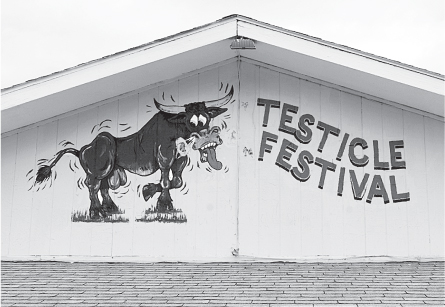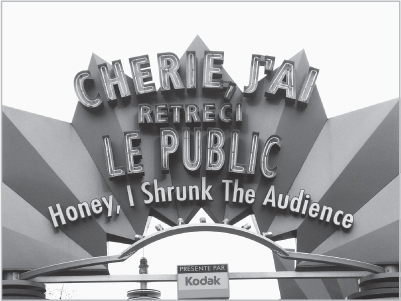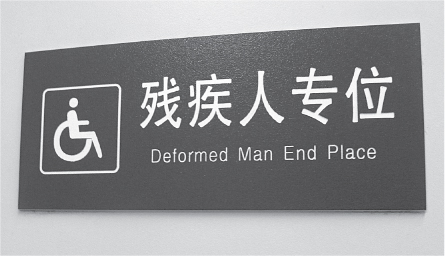Catherine Price (2 page)
Authors: 101 Places Not to See Before You Die

F
orget apple pie. Few foods are as uniquely American as the Rocky Mountain oyster, a euphemism that refers not to a high-altitude mollusk but to the testicles of a bull. Also known as cowboy caviar and Montana tendergroin, these balls can be boiled, sautéed, or even eaten raw, but they’re usually treated more like chicken—breaded and deep-fried.
There are also few things more American than eating competitions, so it should come as no surprise that each summer offers opportunities to prove your manhood by stuffing your face with gonads. I appreciate the pun of the Nuts About Rocky Mountain Oysters competition that occurs annually in Loveland, Colorado. But the award for Best in Show goes to the Testicle Festival, held each year at the Rock Creek Lodge near Missoula, Montana. Started in 1982, it is America’s premier venue to chow down on balls.
When the festival first began, it drew about three hundred people. But these days the crowd has grown to fifteen thousand, and the debauchery has expanded to a weekend full of wet T-shirts, impromptu nudity, and an Indy 500–inspired race called the “Undie 500”—all natural evolutions of an event whose tagline is “Come Have a Ball.” Try your hand at Bullshit Bingo, a larger-than-life—and quite literal—game of chance where every time a bull defacates on a giant bingo card, someone wins $100. Or support the event’s alternate title—the Breasticle Festival—by signing up for the Biker Ball-Biting Competition, where girls riding on the backs of Harleys race to snag a Rocky Mountain oyster off a string without using their hands. There are belly shots. There’s No Panty Wednesday. And, of course, there are the Rocky Mountain oysters themselves—more than fifty thousand pounds of them—greasy, salted, and USDA-approved.

Jim Kleeman
I
magine this scene: you’re walking through an underpass in Connaught Circle, a mess of traffic where twelve of New Delhi’s roads converge, and all of a sudden a voice calls out of the crowd.
“Excuse me, friend,” it says. “You’ve got feces on your shoe.”
Several weeks in India have made you realize that when people yell at you on the street, it’s usually best to ignore them. So at first you pay no attention. But something in this man’s voice is different, believable. He repeats himself, and you slowly lower your eyes.
And there it is: a flattened turd sitting on the top of your shoe.
Your first reaction is disbelief—you’ve had shit on the
bottom
of your shoe, sure. But the top? How can this be? There aren’t any birds around, or monkeys. Disgusted, you lean down to inspect it. Still moist and glistening, it gives off a familiar fecal smell.
You consider throwing up, but before your gag reflex can kick in, a voice pipes up. “Don’t worry, I will clean it for you.” It is your new friend, who now is standing next to you with a shoe-shining kit. Well, will you look at that! Here you are, caught in the one moment in your life where you need an emergency shoe cleaning, and this kind man pops out of nowhere to help you. What are the odds?
Before you have a moment to actually calculate the odds of this happening coincidentally, the man has escorted you off to the side of the passageway where, with a flourish, he rids your shoe of the offending turd. Then, as you reach into your wallet for a tip, he announces the price for a shit-shine special—and it’s more than most New Delhi residents earn in a week.
If you think about it, the scam is brilliant. The service has already been rendered, and besides, who wants to walk around with a turd perched on his shoe?
So you pay him—not his asking price, but still enough to make it worth his while to continue smearing poop on the footwear of passersby. If you’re a victim, feel free to get pissed off. But at least the shit scheme isn’t as bad as the loogie-on-your-shoulder trick. In that one, you don’t even have the chance to give a tip—someone smears a wad of spit on your jacket while a second guy steals your wallet.
I
’ve never liked Disney World. As a child who was terrified of mimes, Santa Claus, and any larger-than-life stuffed animal, I hated the giant mice that roamed the streets of the Magic Kingdom, holding children hostage until their parents took a photograph. Huge, unblinking eyes; garish smiles; swollen, cartoon hands—this was the stuff of nightmares. When my parents brought me to a special event called “Breakfast with the Characters,” I took one look at Pinocchio and dove under the table.
So perhaps I was biased against Euro Disney from the start. But really, who wasn’t? Opened in 1992, it was an attempt to bring Mickey Mouse to Europeans—an audience that tends to be skeptical of American culture to begin with, especially when it tries to steal the hearts and minds of its children. Convinced that parental disapproval was no match for their offspring’s love of
The Little Mermaid
, Disney pushed forward with its plans and eventually settled on a spot in the rural town of Marne-la-Vallée. An easy train ride from Paris, the location was estimated to be less than a four-hour drive for sixty-eight million people.
Controversy soon followed. Assuming that there must be a direct connection between Euro Disney and the U.S. government, French farmers blockaded its entrance with their tractors to protest European and American agricultural policies. A Parisian stage director named Ariane Mnouchkine called Euro Disney a “cultural Chernobyl,” and while she quickly moved on to making other exaggerated comparisons to nuclear disasters (“Television seems to me to be a much more menacing cultural Chernobyl,” she told the
New York Times
in July 1993), the classification stuck.
And then there were tactical errors: Euro Disney opened, for example, in the middle of a European recession. It offended would-be workers with a strict dress code forbidding long nails and requiring “appropriate undergarments” for women, which prompts the question of why a Disney employee would be showing her undergarments to begin with. As a primarily outdoor attraction, it didn’t take into account the fact that France, unlike Florida and Southern California, actually has a winter. The restaurants in the park also didn’t serve alcohol, a policy that didn’t go over well with Europeans used to enjoying a glass of wine with lunch. By July 1993—a little over a year after the park opened—Euro Disney had debts of about $3.7 billion.

Wikipedia Commons
But despite the challenges of translating Americana into every European language (in Italian, Cattleman’s Chili is
Pepperoncino alla Cowboy
) Euro Disney kept fighting. The park posted its first profits in 1995 and has done so intermittently since then. Scarred by the negative connotations of “Euro Disney,” it also changed its name to “Disneyland Paris.” Former Disney CEO Michael Eisner says this title was chosen to identify the park with “one of the most romantic and exciting cities in the world,” but this seems like an odd association—the place is so quintessentially American that it has an Aerosmith-themed roller coaster.
F
irst settled by the Phoenicians over twenty-five hundred years ago, the Spanish island of Ibiza wasn’t always a party town. Back in the day (and by “day,” I mean Carthaginian rule), the club capital of the world was best known for its exports of dye, salt, and wool. Sure, the islanders dabbled in
garum
, a pungent condiment made from fermented fish, but in those days, who didn’t? If people really wanted to party, they went to Rome.
Times have changed. Today Ibiza is known not for its fish sauce but for clubbing, promiscuity, and an abundance of illicit drugs. A favorite holiday destination for the world’s horniest youth, Ibiza’s flesh-baring clientele and encouragement of casual sex have earned it the nickname “Gomorrah of the Med.”
Until recently, the government was happy to bear the responsibility for a few extra STDs in exchange for the purchasing power of thousands of hormonally fueled visitors. But then, after some thirty years of tolerance, it closed several prominent clubs for part of the 2007 season, citing evidence of illegal drug use. Among its arguments: one of the clubs had telephone booths that contained traces of cocaine, snorting tubes, bloody tissues, and, incidentally, no phones. But with possible sexual partners on all sides anyway, who would have needed to place a call? When the clubs eventually reopened, it was with limitations: the government banned clubs from operating past 6 in the morning (they used to stay open all day), and is now trying to actively push Ibiza as a family vacation destination.
Considering that Ibiza has thousands of years’ worth of archaeological remains—not to mention several UNESCO World Heritage Sites—this isn’t entirely preposterous. And yet, I still find it difficult to imagine a family vacation in the midst of an Ibizan summer. Where would you take the kids first? Amnesia, a giant club famous for its foam parties? Or Es Paradis, where every night thousands of ample-bosomed girls wearing white T-shirts are sprayed with a fire hose?
Pick your poison, but don’t let the kids leave Ibiza without an outing to Privilege, the world’s largest club. With a capacity for ten thousand people, its airplane hangar–size space offers something for everyone: you and your spouse can gyrate with thousands of sweaty partiers next to the indoor pool while a stranger teaches your five-year-old how to spell “ecstasy” and your teenager samples ketamine in the bathroom. Just make sure that if your family gets separated, no one tries to find a phone.
W
hen you’re dealing with two languages as different as Chinese and English, it’s inevitable that some things get lost in translation. Handicapped bathrooms are occasionally referred to as “Deformed Man End Places.” In Dongda, the proctology center used to be known as the Hospital for Anus and Intestine Disease. Occasionally, a place receives a title that's both bizarre-sounding
and
mundane. Case in point: the Beijing Museum of Tap Water.
The history of Beijing’s tap water dates back to 1908, when the Empress Dowager Cixi supported a plan to build a water system for Beijing. The museum, however, is a recent addition—it’s the result of a 2001 edict requiring that 150 new museums open in Beijing by 2008. As any curator can attest, 150 is an awful lot of new museums to build in seven years. The result: in addition to tap water, Beijing also now has museums devoted to honeybees, red sandalwood, and goldfish.
Housed in a former pump house, the tap water museum starts with the founding of Beijing’s first water company, the Jingshi Tap Water Co., and features artifacts like vintage water coupons and a stethoscope used to listen for water leaks. It also boasts not just 130 “real objects,” but 110 pictures, 40 models, and a miniature tap water filtration system. Step aside, Forbidden City.
The weirdest thing about the museum, though, is that the substance it’s meant to commemorate—clean tap water in Beijing—doesn’t actually exist. Yes, in 2007 Beijing was the first Chinese city whose water officially passed a test for 106 contaminants. But thanks to the condition of the pipes transporting it from stations to people’s taps, it’s still unsafe to drink.

Molly Loomis
